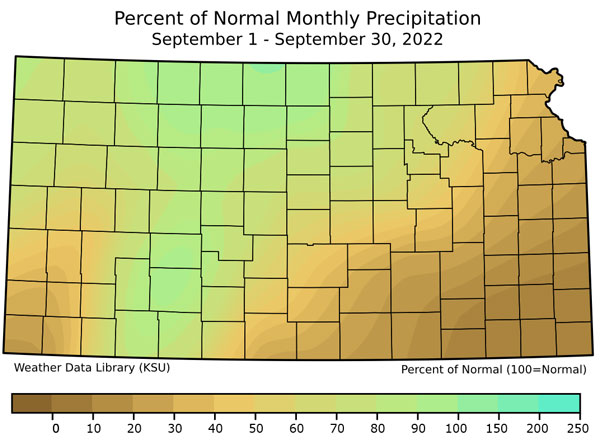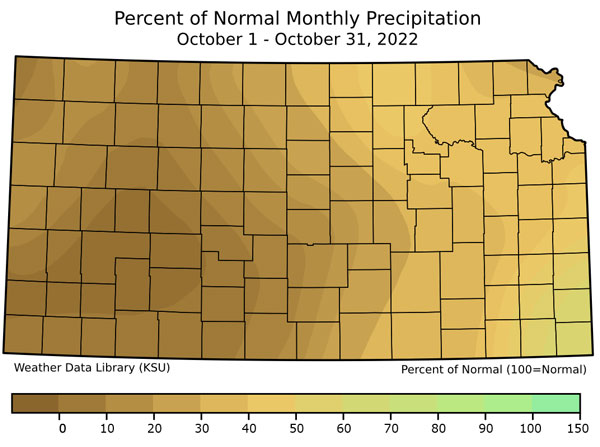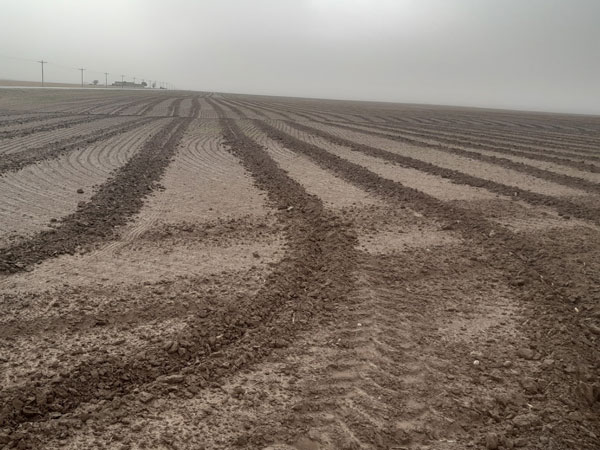Many fields in Kansas failed to emerge in the fall of 2022. Emergence has been highly variable all winter and spring, and some fields are still trying to emerge. Ideally, emergence would occur in October when the bulk of the wheat is planted around the state. However, precipitation has been low and highly variable, resulting in some portions of counties affected having established stands, while other portions of the county have very little establishment. Figure 1 shows the percent of normal precipitation for Kansas during September and October. The southwest portion of the state was the most affected, but portions of northwest and western south central Kansas also have fields that are yet to emerge.


Figure 1. Percent of normal precipitation during the months of September and October 2022. Maps courtesy of the Weather Data Library.
Given that the last wheat season was already extremely dry, and it was followed by a majority dry summer as well, the dry conditions have persisted for over a year in some places of the state, meaning that subsoil moisture is very likely not available or very limited. Consequently, even wheat fields that were planted timely can have poor and variable emergence, with some seedlings that have emerged and died (some that germinated but met a surface crust, forming a yellow accordion-like shape below ground and perishing), and some seed has yet to germinate/emerge. Late-emerged winter wheat has considerably less yield potential than a crop that emerged at the optimum time. Late-emerging wheat may have experienced more winter injury and will have fewer tillers. Producers will have to decide whether maintaining the crop is a viable option.
Reasons for the generally observed decreased yield potential with a delay in sowing date include:
- Less fall tillering potential: fall-formed tillers are generally more productive than spring-formed tillers. When wheat is sown late, it will have less time to tiller in the fall, which decreases the production of higher-yielding tillers as well as total tiller production.
- Delayed cycle: late sowing often delays the entire crop cycle as compared to a crop sown earlier. As a consequence, the grain filling period might occur a few days later and under hotter air temperature conditions, which decreases yield and test weight.
- Greater exposure to winterkill: a wheat crop with 3 – 5 fall-formed tillers has greater cold tolerance than a crop that has only one or two tillers. As a consequence, late-sown fields might be more exposed to winterkill, especially in dry conditions. Since many fields didn’t emerge until spring they avoided winter injury.
- Vernalization: the process where winter wheat plants need exposure to cool temperatures to produce grain production. Seedlings do not require emergence for vernalization, but the seed must imbibe water. It is quite possible, as dry as conditions were, that seed did not imbibe water. The crop needs 6-8 weeks of soil temperatures below 49F to turn reproductive. Depending on how late the crop emerges, it may not even vernalize on time meaning that if this cold criterion is not met, the head may not be formed.
Research conducted by Merle Witt with late-sown wheat in Garden City from 1985 through 1991 is summarized in Figure 2. Averaged across all these years, delaying wheat sowing from October 1 to November 1 delayed the heading date by 6 days and decreased wheat yields by 23%. The grain-filling period was progressively shortened by about 1.7 days and occurred under hotter temperatures (about 1.5°F) for every month of delay in sowing date. Wheat planted on April 1 produced no grain yield and several fields are yet to emerge. Those fields will produce little to no grain yield.

Figure 2. Wheat grain yield, test weight, and heading date responses to sowing date between 1985 and 1991. Data adapted from Kansas Agric. Exp. St. SRL 107.
In summary, the potential consequences of the delayed progress of the Kansas wheat crop include greater exposure to winterkill, a delayed crop cycle for grain filling under warmer conditions, a lower yield potential due to decreased fall tillering, and no vernalization required for grain production. Research evaluating the effects of weather conditions on long-term wheat yields were influenced the most by favorable precipitation conditions during the fall that promoted stand establishment and tillering by moist soil conditions (Holman et al., 2011). However, if there is a good stand established and weather conditions during the remaining season are favorable (mild winter, and cool and moist spring), the crop might still produce a decent yield. Unfortunately, the long-range outlook for spring precipitation is not favorable.
Even if the wheat crop yield outlook is poor, leaving the crop growing might be the best option at this point. Many fields have experienced blowing soil and having some ground cover established would help reduce soil erosion. If moisture conditions improve a summer forage or grain crop could be planted. Some fields have had emergency tillage implemented to reduce soil erosion (Figure 3). See this past eUpdate article on emergency tillage to mitigate wind erosion.

Figure 3. Emergency tillage implemented in a poorly established winter wheat field to prevent soil erosion in Finney County, KS taken 3/22/2023 by John Holman.
Holman, J.D., A.J. Schlegel, C.R. Thompson, and J.E. Lingenfelser. 2011. Influence of Precipitation, Temperature, and 56 Years on Winter Wheat Yields in Western Kansas. Crop Management 10(1), available at: https://dl.sciencesocieties.org/publications/cm/abstracts/10/1/2011-1229-01-RS
John Holman, Cropping Systems Agronomist, Southwest Research-Extension Center
jholman@ksu.edu
Romulo Lollato, K-State Wheat and Forage Specialist
lollato@ksu.edu
Tags: wheat delayed emergence